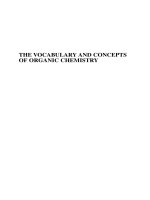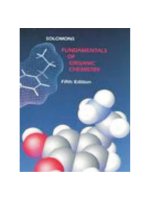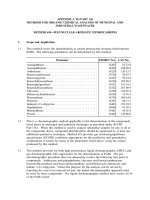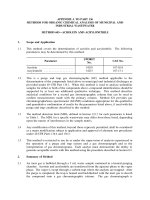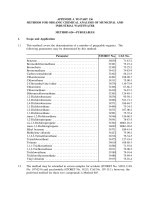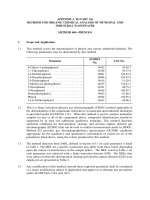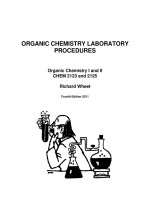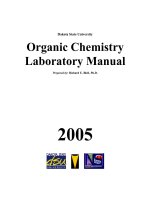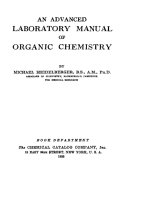gattermann - laboratory methods of organic chemistry
Bạn đang xem bản rút gọn của tài liệu. Xem và tải ngay bản đầy đủ của tài liệu tại đây (4.61 MB, 449 trang )
LABORATORY METHODS
OF
ORGANIC CHEMISTRY
BY
L. GATTERMANN
COMPLETELY REVISED
BY
HEINRICH WIELAND
TRANSLATED FROM
THE TWENTY-FOURTH GERMAN EDITION
BY
W.
MCCARTNEY, PH.D.(EDIN.), A.I.C.
LATE ASSISTANT
IN THE
DEPARTMENT
OF
MEDICAL CHEMISTRY, UNIVERSITY
OF
EDINBURGH
WITH
59
ILLUSTRATIONS
IN THE
TEXT
NEW YORK
THE MACMILLAN COMPANY
1937
COPYRIGHT
PRINTFD IN GREAT BRITAIN
BY B. & R. CLARK, LIMITED, EDINBUMGH
PEEFACE TO THE TWENTY-FOUBTH EDITION
WHILE the student is being educated in preparative work it is
necessary for him to acquire some knowledge of the incessant pro-
gress in the methods of organic chemistry and at the same time to
become familiar with the most recent results of research work. For
these reasons a series of changes had to be made when this new
edition was prepared. In order not to increase the bulk of the book
these objects have been attained by sacrificing examples {e.g. lino-
lenic acid, crystal violet, Gattermann-Koch aldehyde synthesis)
with which, from this point of view, it seemed possible to dispense.
Of the newly included methods two may be mentioned here :
analysis by
chromatographic
adsorption which has attained such
great importance, and the
ozonisation
of unsaturated compounds by
the recently well-developed procedure.
The section on analytical methods has been completely re-
written because the development of organic chemistry has caused
the macro-methods practised in the classic period, methods which
required considerable amount of material, to come to be regarded as
survivals. The candidate for the Doctor degree, we know, no longer
has to acquire the art of carrying out combustions since he is rightly
unwilling, in practising this art, to sacrifice relatively enormous
amounts of pure substance, often laboriously obtained. On various
grounds I doubt the advisability of including micro-analysis in
general practical courses.
During a period of two years we have obtained such good results
in this laboratory with a procedure worked out, on the basis of
Pregl's method, by Dr. F. Holscher that I have included it in this
book. For this procedure 20-30 mg. of substance are required.
The position has been reached where the candidate for the Doctor
vi LABOEATORY METHODS OF ORGANIC CHEMISTRY
degree who reaps from his investigation a harvest not altogether
too scanty and too precious, again carries out himself the com-
bustion of his substances.
It will be understood that, in working out this " meso-analytical "
method now recommended we have made use, not only of the funda-
mental principles of Pregl, but also of all practical and tested
improvements of other authors. (I propose the term " meso-
analytical " instead of the clumsy " half-micro ".)
A reprint of the English edition of the book has appeared, and
I have by chance learned that it has been translated into Russian
and already published in two very large editions in Soviet Russia.
An Italian translation is in course of preparation.
I again have to thank several colleagues for valuable suggestions.
In particular I have to thank
Prof.
F. G. Fischer, Freiburg, and
Dr. Elisabeth Dane, as well as my teaching assistant Dr. G. Hesse,
for their active collaboration in the revision of the book. The
proofs have been corrected by T. Wieland.
HEINRICH WIELAND
MUNICH,
June
1935
PREFACE TO THE KEVISED (NINETEENTH)
EDITION
IT
is rather more than thirty years ago since Ludwig Gattermann
published the first edition of his Anleitung fur das organisch-chemische
Praktikum. The plan of providing the preparative directions with
theoretical explanations has certainly proved satisfactory. That
is already shown by the wide circulation of the book, of which
eighteen editions have appeared. Methodology and technique are
undoubtedly the chief objects of the practical course, but aiming
merely at culinary art and technical achievement such a course
does not accomplish enough. A command of methods implies above
all an understanding of their rationale and a power of adapting
their numerous modifications to particular requirements; the
architect is more important than the mason. We demand that
the student should be conversant with the theory of the transfor-
mations which he carries out practically. The comments made
on the individual preparations are intended to facilitate a survey
of the subject in hand, and to encourage the use of text-books
and journals by further reading. Now that a knowledge of the
principles of organic chemistry may be assumed during the pre-
parative work in German universities, the danger of such com-
ments becoming a pons asinorum is remote.
In rewriting the book the theoretical and practical requirements
have been deliberately increased. The equipment which sufficed
during the last three decades has now become insufficient for those
who desire to work at present-day problems, where difficulties
have been accentuated alike in pure science and in technology.
The idea of making the preparative work at once an explanation
and a living experience of the science has demanded a rearrange-
viii LABOKATOKY METHODS OF ORGANIC CHEMISTEY
ment of the subject matter in accordance with systematic relation-
ships.
It will be seen that the new arrangement does not depart
seriously from the path which ascends from the more simple to the
more difficult. In any case a considerable educational advantage
may be expected to result from the rounding off of successive sub-
jects.
The general part as well as the analytical have been completely
revised and greatly shortened in order to make more space for the
preparative part. The increase in the number of preparations is
intended to provide variety, and to counteract a tendency towards
stereotyped routine in the organic practical course.
I am greatly indebted to my assistants, especially to Drs. Franz
Bergel and F. Gottwalt Fischer, for untiring co-operation in carrying
out numerous experiments. Dr. Fischer has, moreover, drawn the
new diagrams for this edition and has prepared the index.
HEINEICH WIELAND
FEEIBURQ
I. B.,
Master
1925
CONTENTS
A. SOME GENERAL LABORATORY RULES
PAGE
Reaction Velocity and Temperature 1
Purification of Organic Substances 3
Crystallisation 4
Chromatographic adsorption . . . . . .14
Distillation 15
Sublimation 26
Distillation with Steam . . . . . . .27
Evaporation of Solvents 29
Extraction 32
Working with Compressed Gases 35
Heating under Pressure 37
Stirring and Shaking 38
Determination of the Melting Point . . . . . .40
B.
ORGANIC ANALYTICAL METHODS
Detection of Carbon, Hydrogen, Nitrogen, Sulphur, and the Halogens . 43
Organic Elementary Analysis . . . . . .46
I. Determination of Nitrogen by Dumas' Method . . .47
II.
Determination of Carbon and Hydrogen by Liebig's Method . 55
III.
Determination of Halogen, Sulphur, and other Elements . . 69
1.
Determination of halogen by the Carius method, p. 69; 2.
Argentometric determination of chlorine and bromine, p. 73 ;
3.
Iodine determination by the Leipert-Munster method, p. 76 ;
4.
Determination of sulphur by the Carius method, p. 77 ; 5. Deter-
mination of sulphur by combustion, p. 78; 6. Simultaneous
determination of halogen and sulphur, p. 79; 7. Determination
of other elements, p. 79.
IV. Determination of Organic Groups . . . . .80
1.
Volumetric determination of methoxyl and ethoxyl, p. 80;
2.
Determination of the acetyl and benzoyl groups, p. 82; 3.
Determination of active hydrogen by the method of Tschugaeff
and Zerevitinoff, p. 84.
V. Determination of Molecular Weight . . . . .86
x LABOKATOKY METHODS
OF
OEGANIC CHEMISTKY
C. PREPARATIVE PART
PAGE
On
the
Prevention
of
Accidents
88
Equipment required
by the
Beginner
. . . . .90
I. THE
REPLACEMENT
OF
HYDKOXYL
AND
HYDEOOEN
BY
HALOGEN.
ALCOHOLS
AND
OLEFINES
1.
Ethyl bromide from ethyl alcohol
. . . . .93
• Methyl bromide,
p. 95.
2.
Ethyl iodide from ethyl alcohol
. . . . . .95
Methyl iodide,
p. 96.
3.
Benzyl chloride from toluene
100
4.
Bromobenzene
103
p-Dibromobenzene,
p. 105.
5.
Ethylene from ethyl alcohol. Ethylene dibromide
. . . 107
6. Glyool from ethylene dibromide
. . . . . .114
7.
Isoamyl ether
. . . . . . . .117
8. Chloroacetic acid from acetic acid
and
chlorine
. . . .118
II.
CABBOXYLIC
ACIDS
AND
THEIR
SIMPLE
DERIVATIVES
1.
Acid chlorides
121
(o) Acetyl chloride,
p. 121 ; (A)
Benzoyl chloride,
p. 121 ;
Acetanilide,
p.
125 ;
Benzoyl peroxide,
p. 125.
2.
Acetic anhydride
. . . . .
t
. .126
3.
Acetamide
129
Benzamide,
p. 130.
4.
Urea
and
semicarbazide
. . . . . . .131
(a) Potassium cyanate
by
oxidative fusion,
p. 131 ; (6)
Urea,
p. 132 ;
(c) Semicarbazide,
p. 134; (d)
Urea
(and
uric acid) from urine,
p. 135.
5.
Nitriles
. 137
(a) Acetonitrile,
p. 137 ; (b)
Benzyl cyanide,
p. 137.
6. Hydrolysis
of a
nitrile
to the
acid. Phenylacetic acid
. . 140
7.
Esters
141
(a) Ethyl acetate from acetic acid
and
alcohol,
p.
141, Ethyl benzoate,
p.
141 ; (b)
Isoamyl nitrite,
p. 146,
Ethyl nitrite,
p. 147 ; (c)
Ethyl
nitrate,
p. 148 ; (d)
Hydrolysis
of fat or
vegetable
oil, p. 149 ;
Prepara-
tion
of the
free fatty acid,
p. 150,
Glyoerol,
p. 150;
Analysis
of
fats,
p.
151.
8. Conversion
of
carboxylic acids into
the
next lower amines
. .152
(a)
The Hofmann reaction. Methylamine from acetamide, p. 152 ;
(b) The Curtius reaction, p. 153, Benzoyl azide, p. 153, Phenyl
cyanate, p. 153, Phenylurethane, p. 154.
CONTENTS x
III.
NrTRO-COMPOtTNDS AND THEIR REDUCTION PRODUCTS
PAG]
1.
Nitromethane . . . . . . . 15(
Methylamine, p. 158, N-Methylhydroxylamine, p. 158, Methyl-
nitrolio acid, p. 158, Silver fulminate, p. 159, Phenylnitroethylene,
p.
160.
2.
Nitration of an aromatic hydrocarbon . . . . .161
(a) Nitrobenzene, p. 161 ; (b) Dinitrobenzene, p. 162.
3.
Reduction of a nitro-compound to an amine 16£
(a) Aniline from nitrobenzene, p. 165, Diphenylthiourea, Phenyl-
isothiooyanate, p. 169; (6) ro-Nitraniline from m-dinitrobenzene,
p.
171.
4.
Phenylhydroxylamine . . . . . . .174
y-Aminopheno], p. 176, Nitrosophenylhydroxylamine, p. 177.
5.
Nitrosobenzene . . . . . . . . 17S
Nitrosobenzene from aniline and Caro's acid, p. 179, Azobenzene
from aniline and nitrosobenzene, p. 181, Azoxybenzene from phenyl-
hydroxylamine and nitrosobenzene, p. 182.
6. Hydrazobenzene and azobenzene 183
(a) Hydrazobenzene, p. 183; (b) Azobenzene from hydrazobenzene,
p.
184; (c) Benzidine from hydrazobenzene, p. 186. Mechanism of
the reduction of nitrobenzene, p. 188.
IV. SULPHONIO ACIDS
1.
Benzene monosulphonic acid from benzene and sulphuric acid . 191
Diphenylsulphone, p. 191, Benzenesulphonyl chloride, p. 192,
Benzenesulphonamide, p. 192, Benzenesulphohydroxamic acid, p.
192.
2.
Toluene-y-sulphonic acid 193
3.
Naphthalene-/3-sulphonic acid 194
4.
Sulphanilic acid from aniline and sulphuric acid . . . 195
5.
2 : 4-Dinitro-a-naphthol-7-sulphonic acid (naphthol yellow 8) . 195
Thiophenol, p. 201.
V. ALDEHYDES
1.
Formaldehyde 203
Determination, p. 204.
2.
Acetaldehyde 205
(a) From ethyl alcohol, p. 205 ; (6) from acetylene, p. 209.
3.
Benzaldehyde from benzylidene chloride 209
Paraldehyde, p. 217, Metaldehyde, p. 217.
4.
Cannizzaro's reaction. Benzoic acid and benzyl alcohol from
Jbenzaldehyde 220
xii
LABORATORY METHODS
OF
ORGANIC CHEMISTRY
PAQE
5.
Aoyloin
condensation.
Benzoin from benzaldehyde
. . . 222
Benzil from benzoin, p. 222, Benzilic acid, p. 225.
6. Addition of hydrogen cyanide to an aldehyde. Mandelic acid from
benzaldehyde
227
7.
Alanine 229
8. Perkin's synthesis. Cinnamic acid from benzaldehyde and acetic
anhydride 232
Hydrogenation of cinnamie acid, p. 234, Sodium amalgam, p. 234.
9. The Reimer-Tiemann synthesis. Salicylaldehyde from phenol and
chloroform
235
;p-Hydroxybenzaldehyde, p. 236.
VI. PHBUOLS AND ENOLS. KETO-ENOL TAUTOMERISM
1.
Conversion of a sulphonic acid into a phenol. /?-Naphthol . . 239
Phenyl benzoate, p. 241, Naphthyl benzoate, p. 242, Tribromo-
phenol, p. 242.
2.
Methylation of phenols
244
(a) Anisole, p. 244 ; (b) /3-Naphthyl methyl ether, p. 244.
3.
Ortho- and para-Nitrophenols
246
4.
Kolbe's salicylic acid synthesis
249
5.
Synthesis of the ester of a /3-keto-acid. Acetoacetic ester . . 251
6. Acetylacetone
252
Benzoylacetone, p. 253.
7.
Diethyl malonate
254
Diethyl ethylmalonate, p. 254, Ethylmalonic acid, p. 255, Butyric
acid from ethylmalonic acid, p. 255.
8. Phenykutromethane
256
(a) aci-Phenylnitroacetonitrile sodium, p. 256 ; (6) Sodium salt of
aci-phenylnitromethane, p. 256.
On keto-enol tautomerism
257
The use of ethyl acetoacetate and ethyl malonate for synthetic
purposes
264
VII. THE DIAZO-COMPOUNDS
General
269
A.
Aliphatic Diazo-Compounds
1.
Diazomethane . . . . . . . .271
Nitrosomethylurea, p. 271.
2.
Ethyl diazoacetate
275
(a) Glycine ethyl ester hydrochloride, p. 275, Hippuric acid, p. 277 ;
(b)
Ethyl
diazoacetate,
p. 277.
CONTENTS xiii
B.
Aromatic Diazo-Compounds
PAGE
3.
Biazotisation
of
aniline. Phenol, iodobenzene,
and
benzene from
aniline. Isomerism
of the
diazo-compounds
. . . 281
(a) Preparation
of a
solution
of a
diazonium salt,
p. 281 ; (6) Con-
version
of the
diazonium salt
to
phenol
by
boiling
the
solution,
p. 282 ;
(c) Iodobenzene from aniline,
p.
283, Phenyl iodoohloride, Iodosobenzene,
Iodobenzene,
p. 284; (d)
Benzene from aniline,
p. 285; (e)
Solid
phenyldiazonium chloride,
p. 286,
Phenyldiazonium nitrate,
p. 287,
Phenyldiazonium perhromide,
p.
289, Pheny] azide,
p. 289 ; (/)
Sodium
jj-nitrophenyl-amM-diazotate,
p. 290.
4.
23-Tolunitrile from p-toluidine (Sandmeyer's reaction)
. . . 291
Benzonitrile,
p.
292, ^i-Toluio acid,
p. 292.
5.
Arsanilic acid from p-nitraniline
293
6. Phenylhydrazine
296
Benzene from phenylhydrazine,
p. 299 ;
Synthesis
of
indole,
p. 299.
7.
Preparation
of
azo-dyes
300
(a) Helianthine,
p. 300 ; (6)
Congo
red, p. 302 ; (c)
/3-Naphthol orange,
p.
303,
Diazoaminobenzene
and
p-aminoazobenzene,
p. 303.
On
the
coupling reaction
of the
diazo-compounds
. . . 305
VIII.
QDINONOID
COMPOUNDS
1.
Quinone from aniline
309
Quinol,
p. 311,
Anilinoquinone,
p. 311,
Quinhydrone,
p. 314.
2.
jJ-Mtrosodimethylaniline
. . . . . . .314
Dimethylamine
and
y-nitrosophenol,
p. 316.
3.
2>-Aminodimethylaniline
317
Wurster's
red, p. 319,
Bindschedler's green,
p. 321,
Methylene blue,
p.
322.
4.
Basic triphenylmethane dyes
324
Malachite green from benzaldehyde
and
dimethylaniline,
p. 324,
Lead dioxide,
p. 325.
5.
Pluorescein
and
eosin
326
Triphenylmethane dyes. Theoretical considerations
. . . 327
6. Alizarin
334
IX. THE
GRIGNARD
AND
FRIEDEL-CBAFTS
SYNTHESES.
ORGANIC
RADICLES
The Origntard Reaction
1.
Preparation
of
alcohols
337
(a) Benzohydrol from benzaldehyde
and
phenyl magnesium bromide,
p.
337 ; (6)
Triphenylcarbinol from ethyl benzoate
and
phenyl
mag-
nesium bromide,
p. 338.
2.
Synthesis
of a
ketone from
a
nitrile. Acetophenone
. . . 338
xiv LABOKATORY METHODS OF ORGANIC CHEMISTRY
The Friedel-Crafts Synthesis
J
PAGE
3.
Synthesis of a ketone 343
(a) Benzophenone from benzoyl chloride and benzene, p. 343 ; the
Beckmann rearrangement, p. 344; (6) Acetophenone from benzene
and acetic anhydride, p. 346.
4.
Triphenylchloromethane from benzene and carbon tetraohloride . 346
5.
2 : 4-Dihydroxyacetophenone from resoroinol and acetonitrile . 347
6. Quinizarin from phthalic anhydride and quinol . . . 348
Organic Radicles
7.
Hexaphenylethane 362
8. Tetraphenylhydrazine 365
Diphenylnitrosamine, p. 357.
X. HETEEOCYOIIC COMPOUNDS
1.
Pyridine derivatives 361
(a) Hantzsch'a collidine synthesis, p. 361 ; (b) a-aminopyridine, p. 365.
2.
Quinoline 366
(a) Skraup's quinoline synthesis, p. 366; (6) Quinaldine synthesis of
Doebner and Miller, p. 367.
3.
Indigo 369
Phenylglycine, p. 369, Indoxyl fusion, p. 369, Indigo vat, p. 372,
Dehydroindigo, p. 374.
XI. HYDROGENATION AND REDUCTION. OZONISATION
1.
Catalytic hydrogenation with palladium 376
Preparation of palladinised animal charcoal, p. 378; Preparation of
platinum oxide, p. 379.
2.
Catalytic hydrogenation with nickel. Cyclohexanol . . .379
Cyclohexane, p. 381.
3.
Replacement of the oxygen in carbonyl compounds by hydrogen.
(Reduction by Clemmensen's method) 383
(a) Ethylbenzene from aoetophenone, p. 383; (6) Dibenzyl from
benzil, p. 383.
4.
Adipic aldehyde from cyclohexene by ozonisation . . . 384
XII. NATURAL PRODUCTS
1.
Furfural . 386
2.
rf-Glucose from cane sugar 388
3.
Hydrolysis of cane sugar by saccharase 388
4.
/S-Penta-acetylglucose and a-acetobromogluoose . . . 390
CONTENTS xv
PAGE
5.
Lactose
and
casein from milk
391
Ac'd hydrolysis
of
casein,
p.
392.
6. d-Galactose from lactose
393
Muoic acid,
p.
393, Pyrrole,
p.
393.
7.
Octa-acetylcellobiose
and
cellobiose
394
Some remarks
on
carbohydrates
395
8. Saccharification
of
starch
and
alcoholic fermentation
. . 401
9. d-Arginine hydrochloride from gelatin
404
10.
Caffeine from
tea 405
11.
Nicotine from tobacco extract
406
12.
Haemin from
ox
blood
407
Chromatographic adsorption
of
pigment from leaves
. . . 410
13.
The
chief constituents
of ox
bile
. . . . .411
Glycocholic acid,
p. 411,
Chollo acid,
p. 412,
Desoxycholic acid,
Fatty acids,
and
Cholesterol,
p.
413.
Hints
for
using
the
Literature
of
Organic Chemistry
. . . 419
Preparations from
the
Original Literature
422
Table
for
Calculations
in the
Determination
of
Nitrogen
. . 424
INDBX
427
xvi LABORATORY METHODS OF ORGANIC CHEMISTRY
ABBREVIATIONS
The abbreviations of the titles of journals are those employed in British
Chemical Abstracts. The abbreviated title is followed by the year, volume
number (in heavy type), and page.
Amer. Chem. J.
Annalen
Ann.
chim.
Ber.
Ber. deut. hot. Ges.
Bull. Soc. chim.
Chem.
Fabr.
Chem.
News
Chem.
Zentr.
Chem Ztg.
Compt.
rend.
Helv. Chim. Acta
= American Chemical Journal.
= Justus Liebig's Annalen der Chemie.
= Annales de chimie [et de physique].
= Beriohte der deutsohen chemischen Gesellschaft.
= Beriohte der deutschen botanischen Gesellschaft.
= Bulletin de la Societe chimique de France.
= Die chemische Fabrik.
= Chemical News.
= Chemisches Zentralblatt.
= Chemiker-Zeitung.
= Comptes rendus hebdomadaires des seances de
1'Aca-
demie des Sciences.
= Helvetica Chimica Acta.
J. Amer. Chem. Soc. = Journal of the American Chemical Society.
J.C.8.
J. pr. Chem.
J.S.C.I.
Mikrochem.
Monatsh.
Bee. trav. chim.
Z. anal. Chem.
Z. angew. Chem.
Z. anorg. Chem.
Z. Elektrochem.
Z. physikal. Chem.
Z. physiol. Chem.
= Journal of the Chemical Society.
= Journal fur praktische Chemie.
= Journal of the Society of Chemical Industry.
= Mikrochemie.
=Monatshefte fur Chemie und verwandte Teile anderer
Wissenschaften.
= Recueil des travaux chimiques des Pays-Bas.
=Zeitschrift fur analytische Chemie.
= Zeitschrift fur angewandte Chemie.
= Zeitschrift fur anorganische und allgemeine Chemie.
=Zeitschrift fur Elektrochemie.
=Zeitschrift fur physikalische Chemie.
= Hoppe Seyler's Zeitschrift fur physiologische Chemie.
A. SOME GENERAL LABORATORY RULES
Reaction Velocity and Temperature.—Reactions with organic sub-
stances take place much more slowly than those which form the
subject matter of a course of practical inorganic and analytical
chemistry. The latter are nearly always ionic reactions, which
proceed with immeasurable rapidity, but organic substances usually
react much more slowly and therefore their preparation requires
to be accelerated by increased temperature. A rise in the tempera-
ture of 10° doubles or trebles the velocity of most reactions. If the
velocity at 20° is represented by v, then on the average that at 80°
is vx2-5
6
. Consequently reactions will proceed in boiling alcohol
about 250 times as fast as at room temperature.
For this reason many reactions of organic substances are
brought about in heated solvents, usually at the boil-
ing point.
The vapour of the solvent is cooled in a condenser
fixed on the reaction vessel in such a way that the
evaporated solvent continuously flows back again.
Tap water is passed through the condenser.
In order to concentrate a solution the solvent is
distilled " through a downward condenser ". For this
purpose various forms of coil condenser are more con-
venient than the Liebig pattern. For working " under
reflux " such coil condensers are less suitable because
of the layers of liquid which form in the coil between
the vapour and the external atmosphere. A con-
denser designed by Dimroth has proved suitable for
both types of work. In it the cooling water passes
through the coil (Fig. 1). In order to prevent con-
densation of water vapour on the coil it is advisable
to fix a calcium chloride tube into the upper opening of the con-
denser.
If a solvent which boils above 100° is used, the water-cooled
l B
Flo.
1
2 EXTEKNAL COOLING
condenser can be replaced by a long, wide glass tube (air condenser).
The condenser is attached to the reaction vessel by means of a
tightly fitting
cork,
which is softened in a cork-squeezer before being
bored. The diameter of the cork-borer chosen should be less than
that of the glass tube for which the hole is made. The borer is
heated in the flame of a Bunsen burner and is driven in a strictly
vertical position through the cork, which stands on the bench with
the narrow end upwards. As far as is practicable, collodion should
not be used for making stoppers gas-tight. In general, rubber
stoppers should not be used in experiments in which they are exposed
to the vapours of boiling organic solvents, since they swell greatly
and also give off soluble constituents which contaminate the re-
action solution.
The highest degree of purity is attained by using apparatus with
standard ground joints (see e.g. Fig. 47); its sole disadvantage is
its rather high price.
External Cooling.—Many reactions which occur with great
evolution of heat require to be moderated. Further, in the pre-
paration of labile substances which might be damaged by a high
temperature, it is often necessary to provide for the cooling of the
reaction mixture. The degree of cooling varies and, depending on
the amount of heat to be removed and on the reaction tempera-
ture necessary, is produced by running tap water (8°-12°), by ice,
which is finely crushed and mixed with a little water, by an ice and
salt mixture (0° to - 20°), or by a mixture of solid carbon dioxide
with ether or acetone (down to -80°). Liquid air is generally
not required in preparative organic work. To prepare freezing
mixtures such as are often required, ice, well crushed in an ice
mill or metal mortar, is thoroughly mixed by means of a small
wooden shovel with about one-third of its weight of rock-salt,
preferably in a low, flat-bottomed glass jar or in a low enamelled
saucepan.
In order to keep a freezing mixture cold for hours (or even over
night) it is transferred to a " thermos " flask, in which the contents of
test tubes pushed into the freezing mixture can be maintained at
low temperatures for a long time. For keeping larger vessels cold in
this way, Piccard has indicated an arrangement easily constructed
from two filter jars placed one inside the other. The bottom of the
outer vessel is covered with kieselguhr until the rim of the centrally
placed smaller jar is level with that of the outer jar. Then the
PURIFICATION OF ORGANIC SUBSTANCES 3
annular space between the jars is likewise packed with pressed down
kieselguhr and its upper portion between the rims is tightly closed
with pitch.
Too little attention is generally paid to the
concentrations
of the
reactants in preparative organic work. With the exception of rare
cases
{e.g.
in intramolecular rearrangements) we are concerned with
reactions of orders higher than the first, and in these several kinds
of molecules—usually two—are involved. Since, according to the
kinetic molecular theory, the velocity of bimolecular reactions is
proportional to the number of collisions between the various dis-
solved molecules and therefore to the product of the concentrations,
ti = C
A
.C
B
.K (K = velocity constant),
it is advisable in all cases where there is no special reason to the
contrary to choose the highest possible concentration for a reacting
solution.
It should always be borne in mind that reduction of the con-
centration to
one-half,
one-quarter, or one-tenth makes the reaction
four, sixteen, or one hundred times as slow.
PURIFICATION OF ORGANIC SUBSTANCES
The substances which form the object of preparative work are
usually solid crystalline materials or liquids—occasionally also gases.
Because of the multiplicity of reactions in which organic substances
can take part, and in pronounced contrast to most reactions of in-
organic chemistry, it is rare for an organic reaction to proceed
strictly in one direction only and to yield a single end-product.
Almost always secondary reactions occur and greatly complicate
the isolation of pure homogeneous substances from a reaction mix-
ture ; this isolation constitutes the chief aim of preparative exercises.
Sometimes several well-defined chemical compounds are produced
at the same time and must be separated ; sometimes it is a question
of separating the required substance with as little loss as possible
from undesirable products which accompany it—the so-called resins
or tars. These terms are used for by-products the origin and nature
of which have usually not been investigated ; sometimes they un-
fortunately become the main product. As regards classical organic
chemistry, they have awakened interest only in so far as they are
regarded as an unmitigated nuisance.
4 CRYSTALLISATION
The substances to be prepared must be freed very carefully from
all these undesirable admixtures. For this purpose two methods
are in principle available :
1.
Crystallisation
2.
Distillation
1. CRYSTALLISATION
General Considerations.—Solid crystallisable substances are
usually obtained at the end of a reaction in the form of a crude
product which separates in more or less pure form from the solvent
on cooling, either directly or after concentration. The rate at
which organic substances crystallise varies within very wide limits,
and their tendency to form supersaturated solutions is extraordin-
arily great. But even when supersaturation is counteracted by
dropping a crystal into the solution—by " seeding "—the attain-
ment of equilibrium in the cold saturated solution is often exceed-
ingly slow. The cause is indeed the slow rate of crystallisation.
Hence the full yield of crude product is often obtained only after
the solution has been left for many hours.
The process of recrystallisation is most simply (and most fre-
quently) carried out as follows : A hot saturated solution of the
crude product in a suitable solvent is prepared, and from this
solution the substance crystallises again in a purer condition. If
the procedure is to succeed it is essential that the impurities should
be more soluble than the substance
itself,
and should consequently
remain dissolved in the cooled solution (the mother liquor).
The principle of differential solubility is also applied conversely,
namely, when the by-product can be separated from the just-satur-
ated solution of the substance because of its low solubility in an
appropriate solvent. Since, in this case, the solution always re-
mains saturated with respect to the by-product, it is never possible
by this method to obtain a substance in one operation, as may be
possible by the first method.
It is also important for recrystallisation from hot saturated
solution that the temperature-solubility curve should rise as steeply
as possible, i.e. that the dissolving power of the solvent should
increase greatly with increasing temperature. In that case only
can the amount of substance taken be recovered from the solution
in the highest possible yield.
CHOICE OF SOLVENT 5
The choice of the right solvent is therefore of great importance
for the process of recrystallisation. The most commonly used
solvents are the following : water, ethyl alcohol, methyl alcohol, ether,
acetone, glacial acetic
acid,
ethyl acetate, benzene, petrol ether, chloro-
form,
carbon bisulphide.
For quite sparingly soluble substances, formic acid, pyridine,
bromobenzene, nitrobenzene, and occasionally also phenol, ethyl
benzoate, aniline, and dioxan are used. A distinct relation exists
between the constitution of solute and solvent, and is expressed by
the old rule : similia similibus solvuntur. Thus, as is well known,
substances containing hydroxyl (e.g. sugars, carboxylic acids) are
soluble in water, whereas hydrocarbons are more soluble in benzene
and petrol ether than, for example, in alcohols.
The above statements, however, generally hold with some degree
of certainty for simple organic compounds only. With complicated
substances the conditions are more involved, and unless the worker
has long experience he is obliged to test the available solvents
seriatim. Alcohol is used most, and with this one usually begins ;
then perhaps water, benzene, and petrol ether. It may be said that,
on the whole, of the more usual solvents, benzene, chloroform, and
ether have a very great, petrol ether and water a moderate solvent
power for organic substances. Although the validity of this rule is
contravened by many substances, it nevertheless gives some indica-
tion for testing purposes. Thvis if the sample is too sparingly
soluble in alcohol a solvent from the first group is chosen; if it is too
soluble, one from the second. In the case of sparingly soluble sub-
stances a higher boiling homologue of the same class is often chosen
—in place of the lower alcohol, propyl or amyl alcohol, instead of
benzene, toluene or xylene—because the higher boiling point brings
about increased solvent power.
It very often happens that the preparation of a substance leads
to an amorphous crude product, resinous or flocculent, which be-
comes crystalline on digestion with a suitable solvent or else by
direct recrystallisation. It must be remembered that the solubilities
of the amorphous and crystalline forms of the same substance are
altogether different, and that the amorphous preparation is always
much the more soluble.
Salts dissolve quite generally with ease in water, and often also
in the alcohols, acetone, and chloroform, but they are not dissolved
by ether, benzene, or petrol ether. Consequently organic acids can
6 CEYSTALLISATION
be extracted by aqueous solutions of alkali, and organic bases by
aqueous solutions of acid, from a mixture of neutral substances in
a solvent like ether.
When a substance has not the necessary moderate solubility in
any solvent but is either too readily or too sparingly soluble, the
combination of different solvents is a useful expedient. The solvents
which are used together must be miscible with each other. The
following are most frequently used :
Alcohol, glacial acetic acid, acetone with water.
Ether, acetone, benzene, chloroform with petrol ether.
Pyridine with water, ether, or alcohol.
The method of procedure is to add the solvent used as diluent
drop by drop to the cold or hot concentrated solution until tur-
bidity is just produced ; crystallisation is then induced by leaving
the liquid to stand or by scratching with a sharp-edged glass rod.
When crystallisation has begun the solution is cautiously diluted
further. It is a mistake to precipitate the dissolved substance at
one stroke with large amounts of the diluent.
In the case of all operations which are not yet under control, pre-
liminary test-tube experiments should be carried out. The student
should acquire the habit of doing this from the very beginning.
Aqueous filtrates should be collected in beakers, but organic
solvents in conical flasks, which prevent evaporation and so check the
formation of crusts. Already in order to obtain some idea of the
degree of purity from the appearance of the crystals, the crystallisa-
tion should be left to go on undisturbed so that crystals may separate
in the best possible form. It is an error to assume that fine crystals
produced by immediate strong cooling of a solution constitute an
especially pure substance ; on the contrary, the large surface of the
deposit favours the adsorption of by-products. Moreover, with well-
formed crystals it is much easier for the organic chemist to meet
the imperative requirement that he should check the homogeneity
of a substance. The examination of the preparation with a lens
or under the microscope should not be neglected; 50- to 100-fold
magnification is sufficient.
If a solution has become saturated at room temperature the
yield of crystals can be increased by placing the vessel in ice-water
or in a freezing mixture.
Substances of low melting point occasionally separate as oils
when their hot saturated solutions are cooled. The solution must
DISSOLVING THE SUBSTANCE
then be diluted somewhat. Moreover, in such cases provision is
made for slow cooling by standing the flask containing the solution in
a large beaker of water at the same temperature and leaving till cold
or wrapping a towel round it. Of substances which crystallise with
difficulty a small sample should always be retained for use as
" seeding " crystals. Separation as an oil may then be obviated by
dropping these crystals into the solution before it has become quite
cold and rubbing with a glass rod.
Procedure.—In order to prepare a hot saturated solution the
substance to be purified is covered, preferably in a short-necked,
round-bottomed flask, with a little solvent which is then heated to
boiling. More solvent is gradually added in portions until all the
substance has dissolved. Since crude substances frequently contain
insoluble impurities, the process of dissolution is carefully watched
to see exactly if and when the compound to be recrystallised has
completely dissolved. On account of the lability of many sub-
stances prolonged boiling is to be avoided. Solutions made with
solvents which boil under 80° are prepared on the boiling water bath
under reflux condenser; the solvent to be added may be poured
into the flask through a funnel placed in the top of the condenser.
It is better, however, at least when using large quantities, to fit a
two-neck attachment (Anschiitz tube, Fig. 30, p. 39) to the flask,
since in this way it is possible to add the solvent conveniently and,
in other cases, to drop in solid substances also. The condenser is
fixed in an oblique position to the oblique tube
of the attachment, whilst the vertical tube,
through which substances are added, is closed
with a cork.
Water and other solvents which boil above 80°
are most suitably heated on an asbestos support
in an air (Babo) oven or on an asbestos-wire
gauze. If the boiling point lies considerably above
that of water (more than 20°) the danger of crack-
ing the condenser must be avoided by circulating
warm water through it, or else the water con-
denser must be replaced by a long, wide glass
tube (air condenser), which may be wrapped in
moist filter paper if necessary. For test-tube ex-
periments under reflux the so-called " cold finger
ceedingly convenient.
FIG. 2
(Fig. 2) is ex-
It consists of a glass tube about 15 cm. long
8 FILTKATION
and from 6 to 8 mm. wide sealed at one end. About 3 cm. from
the other end a narrow tube 3 cm. long is attached at a right angle
and bent downwards so that the apparatus can be hung on an iron
ring. Cooling water is led away thro\igh this side tube to which
thin rubber tubing is attached. The water is led into the " cold
finger " through a bent glass tube which reaches to the bottom and
is fixed in a small piece of rubber tubing which acts as a stopper.
This handy condenser is fitted into the test tube by means of a
notched cork.
The very troublesome " bumping " is avoided by adding porous
pot, in pieces about half the size of a pea, before the boiling begins.
When the pieces of pot become inactive they are replaced by new
ones (do not drop them into superheated solutions !). When violent
bumping occurs in large volumes of solution the addition of wooden
rods is to be recommended.
In order to remove coloured impurities, which often adhere
tenaciously to a colourless substance, the hot saturated solution is
boiled for a short time with a few knife-points of animal charcoal or
specially prepared wood charcoal. Since the air which escapes from
the charcoal causes copious frothing the adsorbent must be added
carefully and with shaking. On account of their colloidal nature the
coloured impurities are most easily adsorbed from aqueous solutions.
Filtration.—Solutions from which crystals are to be obtained
are not completely clear, even in the absence of charcoal, and they
must therefore be filtered. A filter paper in the ordinary conical
form is generally to be preferred to the " folded " paper. The
angle of glass funnels is usually not quite correct, and allowance can
be made for this by making the second fold in such a way that the
straight edges of the paper do not quite coincide and then using the
larger cone for the filtration.
In preparative organic work readily permeable " grained " filter
paper is alone of use.
The dissolved substances (especially if the solution is very con-
centrated) often crystallises in the funnel on account of local cooling
and in this way filtration is hindered. This trouble can be partially
met by using a funnel (Fig. 3) with the delivery tube cut short
(0-5-1-0 cm.). But it is much more satisfactory to use a so-called
hot water funnel (Fig. 4) in which the filtering surface of the funnel
is heated with boiling water in a metal jacket. When inflammable
solvents are used, the flame must be extinguished before filtration.
ISOLATION OF CRYSTALS 9
The steam-heated funnel (as in Fig. 5) is likewise very useful. When
small amounts of liquid are to be filtered, the empty glass funnel may
he heated over a naked flame before use, or the paper may be fixed
FIG. 3
FIG. 4 FIG. 5
in the funnel, moistened with alcohol, ignited, and allowed to burn
till it begins to char, while the funnel is held in a horizontal position
and rotated.
It is often advisable, especially in the case of aqueous solutions
which are difficult to filter, to use a porcelain Biichner funnel and
apply suction. A well-fitting filter paper is required and the filter
flask must be cautiously warmed before use, preferably by standing
it in an enamelled pail of warm water and heating to boiling.
If the filter paper becomes choked by crystallisation of the substance,
it is best not to push a hole through it. The paper should rather be
held upright in a small beaker in which fresh solvent is kept boiling,
and the more dilute solution thus obtained is poured through the same
paper. In such cases the whole solution must generally be concentrated
by evaporation.
If it is desired to produce well-developed crystals when re-
crystallising, the filtrate, in which separation of crystals often occurs
even during filtration, must be reheated till a clear solution is
obtained and then allowed to cool slowly without being disturbed.
The isolation of the crystals is never accomplished by ordinary
nitration, but always by collecting them at the pump on a filter
paper, or, in the case of concentrated acids and alkalis, on glass
wool, asbestos, or, best of all, on Schott filters of sintered glass.
Large amounts of substance are collected on Biichner funnels (Fig.
6) of size appropriate to the quantity of the material to be separated.
10
FILTRATION
It is quite wrong to collect a few grammes of substance on a funnel
six or more centimetres in diameter. In many cases, especially for
FIG. 6 FIG. 7
small amounts (5 g. or less), the Witt filter plate (Fig. 7) is to be
preferred. It presents the advantage that its cleanliness can be
checked much more readily than that of an opaque porcelain funnel,
and, especially, that much less solvent is required to wash the more
compact solid.
In order to prepare the filter paper a small piece of the paper is
folded over the upper edge of the filter plate and then a piece having
a radius 2-3 mm. greater is cut out with scissors. This piece is
moistened with the solvent and fitted closely to the funnel by
pressing, rubbing out small folds with a rounded glass rod or, in
the case of larger plates, with the finger-nail.
When minute amounts of substance (a few
hundred milligrammes or less) have to be fil-
tered, small glass plates 0-5-1 -0 cm. in diameter
are used as supports for the filter paper. These
plates are made from thin glass rods by heat-
ing one end in the blow-pipe till soft and then
pressing out flat on an iron or earthenware
plate (Diepolder). The glass rods must be long
enough and thin enough to pass through the
delivery tube of a quite small funnel and to
project beyond its end. The pieces of filter
paper which rest on the glass plates are cut
than the plates themselves and are made to
FIG. 8
somewhat larger
fit closely (Fig. 8).
FILTRATION 11
In order to remove the substance from the filter plate after filtration
the funnel is inverted over a basin or watch-glass and all the material
is transferred to the latter with the help of a thin glass rod- or copper
wire ; the " glass button " is pushed out from its lower end. The plate
is removed with forceps, but the paper not before it is dry. The
material which adheres to the funnel is removed without loss by scraping
with a small, obliquely cut piece of thin cardboard.
The nitrate is collected in a filter flash of a size appropriate to
the volume of the solution. The very useful filter tube (Fig. 8) in
its various sizes is also employed when filtering on a small scale.
Such tubes stand in a lead support or in a wooden block bored with
holes of various diameters.
In view of its great importance as a method for preparing
analytically pure substances, the technique of filtration deserves
the special attention of the student of practical organic chemistry.
The process of pouring the crystals along with the mother liquor
on to porous plate and subsequently washing is emphatically to be
rejected. Already in the preparation of organic substances the
mind of the beginner should, above all, be directed to working as
much as possible in quantitative fashion. It is not the number of
preparations which indicate success, but the care and thoroughness
with which each separate reaction is carried out.
For these reasons the " mother liquor " must not be treated as
waste and neglected. Its importance will indeed only become clear
to the research worker, but the beginner at preparative work should
extract from it whatever is to be extracted for his purposes.
Filtrates are therefore reconverted into (cold) supersaturated
solutions by evaporation of part of the solvent, and so a second
crop of crystals is obtained. Occasionally yet another crop may be
produced. As a rule the crops so prepared must be recrystallised
once again from fresh solvent (check by melting point determina-
tion !).
A few words should be added about the washing of crystalline
precipitates with the object of freeing them from adherent mother
liquor. The same solvent as was used for crystallisation must
always be employed and, since its solvent power for the substance,
even in the cold, leads to more or less appreciable loss, it must be
used in the smallest possible amounts. Suction should not be applied
while washing; the precipitate is saturated with the solvent and
then the pump is turned on.
